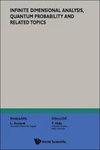COVARIANT QUANTUM FIELDS VIA LORENTZ GROUP REPRESENTATION OF WEYL OPERATORS
IF 0.8
4区 数学
Q4 MATHEMATICS, APPLIED
Infinite Dimensional Analysis Quantum Probability and Related Topics
Pub Date : 2023-11-01
DOI:10.1142/9789811275999_0002
引用次数: 2
Abstract
The building blocks of Hudson-Parthasarathy quantum stochastic calculus start with Weyl operators on a symmetric Fock space. To realize a relativistically covariant version of the calculus we construct representations of Poincare group in terms of Weyl operators on suitably constructed, Bosonic or Fermionic based on the mass and spin of the fundamental particle, Fock spaces. We proceed by describing the orbits of homogeneous Lorentz group on R4 and build fiber bundle representations of Poincare group induced from the stabilizer subgroups (little groups) and build the Boson Fock space of the Hilbert space formed from the sections of the bundle. Our Weyl operators are constructed on symmetric Fock space of this space and the corresponding annihilation, creation, and conservation operators are synthesized in the usual fashion in relativistic theories for space-like, time-like, and light-like fields. We achieve this by constructing transitive systems of imprimitivity (second-quantized SI), which are dynamical systems with trajectories dense in the configuration space, by induced representations. We provide the details of the field operators for the case of massive Bosons as the rest are similar in construction and indicate the ways to construct adapted processes paving way for building covariant quantum stochastic calculus.通过weyl算子的洛伦兹群表示的协变量子场
Hudson-Parthasarathy量子随机微积分的构建模块从对称Fock空间上的Weyl算子开始。为了实现微积分的相对论协变版本,我们根据基本粒子Fock空间的质量和自旋,在适当构造的玻色子或费米子上,用Weyl算子构造了庞加莱群的表示。本文首先描述了R4上齐次洛伦兹群的轨道,建立了由稳定子群(小群)导出的彭加莱群的纤维束表示,并建立了由束的各部分组成的希尔伯特空间的玻色子Fock空间。我们的Weyl算符是在这个空间的对称Fock空间上构造的,相应的湮灭、创造和守恒算符是在类空间、类时间和类光场的相对论理论中以通常的方式合成的。我们通过构造非原性传递系统(二次量化SI)来实现这一目标,非原性传递系统是在组态空间中具有密集轨迹的动力系统。我们提供了大质量玻色子的场算子的细节,因为其他玻色子在构造上类似,并指出了构造适应过程的方法,为构建协变量子随机微积分铺平了道路。
本文章由计算机程序翻译,如有差异,请以英文原文为准。
求助全文
约1分钟内获得全文
求助全文
来源期刊
CiteScore
1.50
自引率
11.10%
发文量
34
审稿时长
>12 weeks
期刊介绍:
In the past few years the fields of infinite dimensional analysis and quantum probability have undergone increasingly significant developments and have found many new applications, in particular, to classical probability and to different branches of physics. The number of first-class papers in these fields has grown at the same rate. This is currently the only journal which is devoted to these fields.
It constitutes an essential and central point of reference for the large number of mathematicians, mathematical physicists and other scientists who have been drawn into these areas. Both fields have strong interdisciplinary nature, with deep connection to, for example, classical probability, stochastic analysis, mathematical physics, operator algebras, irreversibility, ergodic theory and dynamical systems, quantum groups, classical and quantum stochastic geometry, quantum chaos, Dirichlet forms, harmonic analysis, quantum measurement, quantum computer, etc. The journal reflects this interdisciplinarity and welcomes high quality papers in all such related fields, particularly those which reveal connections with the main fields of this journal.

 求助内容:
求助内容: 应助结果提醒方式:
应助结果提醒方式:


